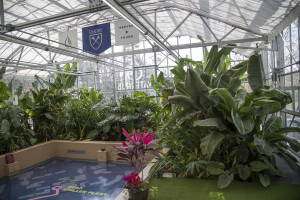
By: Nedra Rhone, The Atlanta Journal-Constitution | March 11, 2020
In 2018, when a water main break left more than 700,000 DeKalb residents under a boil water advisory, the WaterHub at Emory University became a lifeline for the school. During the three days that county residents were forced to survive without potable water, the WaterHub supplied more than 700,000 gallons of water to Emory’s campus, helping to keep HVAC equipment running and reducing the loss of water pressure.
It was a big success for the campus-based water recycling system, which got its start five years ago as a response to metro Atlanta’s ongoing water issues — outdated infrastructure, the tri-state water wars and extreme drought — all of which threaten community water resources.
“In the face of global climate change, we can’t keep doing business as usual. We saw this as a resilience measure,” said Ciannat Howett, director of sustainability initiatives at Emory. “Having a decentralized system is really important and can be helpful.” Serving as a place for students to learn and the public to observe, the Emory WaterHub has been recognized as a leading innovation in water reuse by the U.S. Environmental Protection Agency.
>> RELATED: Green school buildings put metro Atlanta in design spotlight
After five years, the WaterHub has hosted thousands of visitors from around the world and is the model for Sustainable Water’s $500 million initiative to develop 50 eco-engineered water reclamation systems around the country over the next 10 years. Other universities such as Duke and Princeton are considering similar water recycling systems, as are some government and commercial institutions.

The WaterHub looks a lot like a greenhouse. At 3,200 square feet, the glass structure is not much larger than the average American home. On any given day, up to 400,000 gallons of wastewater flow out of the campus sewer system to pipes under the light blue flooring that doubles as a diagram for how the system works. The waste is treated through a series of processes that mimic nature. Biological reactions break down the waste, which is then clarified, purified and disinfected before it is sent back to campus through a purple pipe (the color designated for all recycled water) to be used as toilet water in dorms or water for heating and cooling across campus.
It takes 12-24 hours for the wastewater to go through the treatment process, and about 50,000 gallons of clean water can be stored on campus. Visitors to the WaterHub compare it to a walk through a garden — underground treatment and purifiers in the tanks help control any odor — with layers of natural vegetation.

Just a few decades ago, water reuse was mostly about filling a void in regions of the country that were arid and in need of irrigation, but that is changing, said Zachary Dorsey, spokesman for WaterReuse, an international organization for applied research, policy guidance and educational tools on water reuse.
“Water reuse is no longer thought of as an emergency measure for when you have drought. It is effective when you don’t have enough water, have too much water or have the wrong quality of water.” Closed loop systems like the one at Emory have recently begun to take off and have allowed communities to engage and invest in water reuse, Dorsey said.
>> RELATED: Project at Georgia Tech will use wastewater to grow veggies
But if it were easy, everyone would do it. The most significant barriers, Dorsey said, are cost and education.
“The investment can be high. That is true about all of our water infrastructure. The solution for that is more investment by the federal government through the existing infrastructure programs,” Dorsey said.
Emory relied on public and private partnerships to get the WaterHub built at no cost, Howett said. The university has a long-term contract with private investors who paid the upfront costs. Emory pays the investors to use the water, which costs a lot less over time than the 11% per year rate increases paid to DeKalb County, she said.
The other barrier is getting the public accustomed to viewing recycled water as just plain water. “We have been taught our entire lives that once we have used water, it is a waste product,” Dorsey said. “The education is really to teach people that it is not the source of the water that is important, it is the quality of the water.”

It was a long journey to get students and staff comfortable with reclaimed water, Howett said. The county even required Emory to add blue dye to the recycled water so that students would understand they should not drink it.
Other projects similar to the WaterHub will be coming to the metro area soon, said Bob Salvatelli of Sustainable Water, joining more than a dozen other recognized water innovations around the country that use recycled water for everything from recharging drinking water aquifers to generating electricity.
“We are still at a time when some have not realized how important it is to have resilience as a top priority,” Howett said. “It is also complex and requires deep thinking about water treatment. It is so important that institutions like Emory model that we have a responsibility to treat, use and take accountability for sewage we create on-site.”
